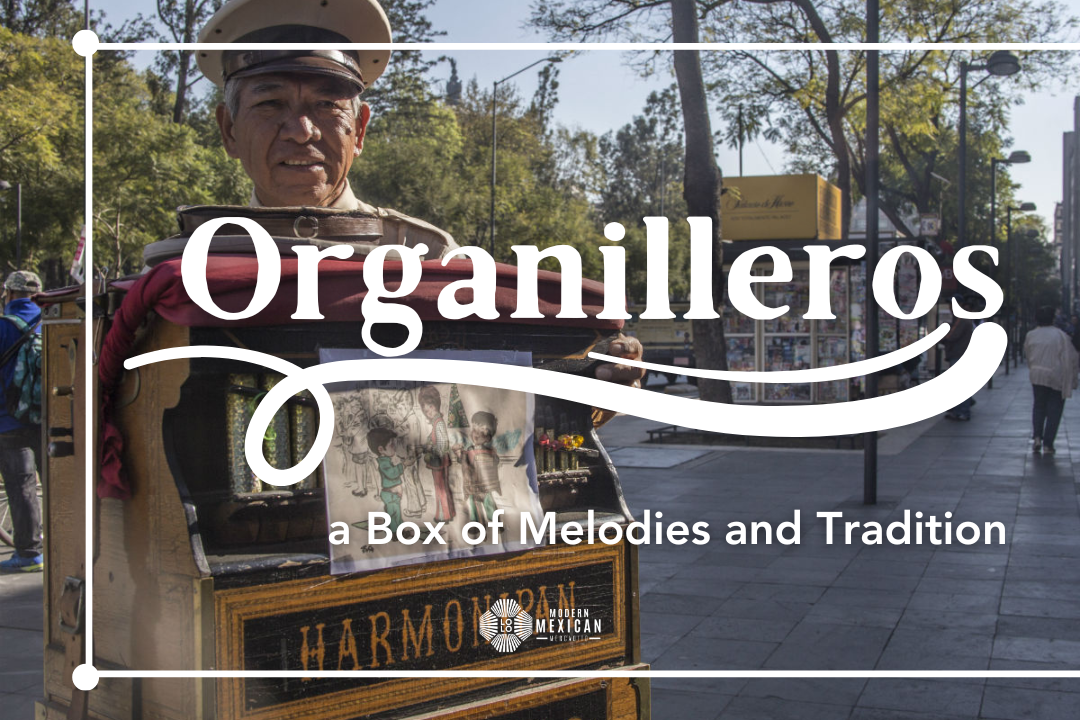There are very few memories I have of my great-grandmother Dolores, and a vivid one is how she used to say “a los organilleros siempre se les tiene que dar una moneda [you should always give a coin to organilleros].” She was loyal to her words and, while walking with the entire family at the Zócalo, she would make us walk through the crowds to drop a coin in the hat of these musicians dressed in military-like uniform.
These organilleros, or organ grinders, are captivating characters you might have seen while wandering the main plazas of Mexico, especially in Mexico City’s Zócalo. They wear traditional beige uniforms and caps and play an odd instrument that makes a slightly mistuned sound.
Recently, our social media was taken over with the news of a US model living and working in Mexico who criticized the sound and trade of organilleros on her social media and received a ton of backlash, which led to her losing her job. She catalogued the organilleros’ sound as “the most annoying sound of Mexico.”
As soon as I read and followed the news, my time with my great-grandmother with the sound of the organillero in the background came straight to mind, and I jumped to learn more about this institution and why my great-grandmother would make it a priority to give our loose change to these organilleros.
So, join me in today’s blog as we share the history, background, and tradition of these elegant and sober street performers and explore what they represent in Mexican culture—something only these news made me wonder.
What are organilleros?
Anyone who has visited Mexico City's historic center will recognize the high-pitched screeching of mildly mistuned street organs playing a popular tune. In fact, we would go as far as saying that if there is one sound that characterizes Mexico City, it is that of organilleros. These street musicians, often seen in traditional attire, play melodies on a large, hand-cranked music box known as an "organillo," for which organilleros get their name. The organillo, a portable barrel organ, carries with it an air of nostalgia and a reminder of times gone by.
What makes organilleros particularly special in Mexico is not the music they play or the instrument they carry: it is the tradition and dedication behind their craft that distinguishes them from any other street performer. These musicians, often dressed in traditional outfits that include a peaked cap and a neatly buttoned vest, embody a living history that connects the past with the present. Their performances are a cultural expression that celebrates the rich musical heritage of Mexico.
Origin
The organillo, of German origin, is a wooden box instrument with brass pins that reproduce its distinctive sound. This instrument gained popularity in Mexico towards the end of the 19th century, facilitated by the presence of German migrant families, like the owners of Wagner and Levien. This music house, also known for its pianos, offered organillos for rent to individuals seeking to make money by playing them in public squares.
During the Porfiriato era, organilleros became popular on the streets of Mexico as the organillos were rented out as a source of employment or for serenading. The instruments, despite their hefty weight of up to 60 kilograms/130 lbs., were carried around by organilleros aiming to collect money. This tradition withstood the Mexican Revolution, a period during which European melodies were gradually replaced with popular Mexican songs and revolutionary anthems such as "Adelita" and "La Cucaracha."
Concerning their uniform, it is no coincidence that the organilleros' uniforms bear a striking resemblance to Pancho Villa's army uniforms, as it is said that an organillero accompanied the militias to encourage them during each battle. As a result, this beige or khaki uniform, complete with a captain-style cap in the same color, alludes to this fact, which is part of our country's popular history.

What’s Inside the Box
An organillo, balanced on a single wooden leg, operates through a refined mechanism that evolved from mechanical systems with wooden cylinders and bronze spikes, to pneumatic systems using perforated cardboard, allowing a wider variety of melodies.
Turning the crank produces the characteristic sound of a barrel organ triggering a series of mechanical events that generate musical notes through the organ’s tubes. The result is a resonant and often joyful melody that spreads vibrantly throughout the environment.
These boxes usually have fine craftsmanship, as they are plated and varnished, and even decorated with flowers at the bottom of the face. In addition, you have a cloth on top and brass details.
Organilleros Today
Although organ grinders were no longer manufactured in Germany after World War II, the large number of organ grinders in Mexico allowed the tradition to continue, as it is a craft passed down from generation to generation. However, this trade is gradually disappearing as modernity takes over urban culture. Currently, only three Latin American countries continue to practice this tradition: Chile, Argentina, and Mexico, with Mexico having the deepest roots in the profession.
Despite its historical roots, cultural value, and role as an integral part of Mexico's urban culture, the profession of organ grinder is now rare. In a digital world where there is easy access to an infinite musical repertoire, cylinders are frequently perceived as obsolete in comparison to modern forms of entertainment. However, its continued existence demonstrates that there are still people who appreciate the authenticity, tradition, and connection to cultural heritage that this invaluable street art provides.

Reflecting on my great-grandmother Dolores’ tradition of giving to organilleros, it strikes a chord about the simple yet profound acts that connect us to our heritage. The organilleros’ role stretches beyond the melodies from their weathered instruments; it's a craft that embodies Mexico’s streets.
The recent controversy stirred by a foreigner’s criticism reminded me that these sounds are not mere background noise. In fact, it got me thinking on how it is crucial to recognize and honor these melodies that have long been the backdrop to street life.
Today, I keep thanking my family for teaching me the value of my culture. Let’s value the organilleros not for nostalgia but for their ongoing narrative in our culture—a narrative that should continue to echo through the streets of Mexico.
---
What do you think? Have you ever heard of organilleros before? Have you ever been in a plaza where organilleros perfom? What was you first reaction to the sound? We’d love to hear your thoughts and experiences! Also, if there’s one topic you’d like for us to write about, let us know in the comments below, we’re always looking for fresh ideas!
Don't forget to subscribe to our newsletter where we make sure to share this and many more authentic and original recipes, as well as content of interest about Mexico and its culture! We also make sure to give our familia of subscribers exclusive promotions, gifts, first-hand look at all new products and, of course, these articles that we love to write for you all!
If you'd like to continue to support our efforts to share our cultura, we invite you to shop our mercadito and take a piece of Mexico home. Your purchase supports artisans in Mexico, a Small-family owned business, and helps us continue writing these blogs!











3 comments
Regina from Lolo Mercadito
i love this
Rosy
I grew up in Guadalajara and when we went to el centro with my mom, we always stopped to listen to the organilleros. I live in the US now, and when I travel with my daughters to GDL, we go back to where the organilleros play their music. They love all those traditions of their mom’s country.
Barbara
I just spent five wonderful days in San Luis Potosi city and there were plenty there. Some had a little stuffed monkey with them.